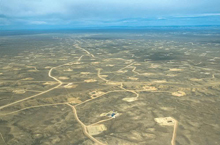The effects of natural gas well pad activity on wildlife
 The controversial Jonah natural gas field in western Wyoming.
The controversial Jonah natural gas field in western Wyoming.
Concern about human impacts to mule deer...
In the field of wildlife conservation, a growing body of research is looking at the effects of human activity on ungulate behavior. A major objective of wildlife managers and researchers in the western United States is to minimize human disturbance to animals such as mule deer whose survival likely depends on minimizing energy expenditures during winter. This issue has become increasingly complex with growing use of remote public lands for activities such as recreation and natural gas production.
In places like the the Pinedale Anticline Project Area in Western Wyoming, companies are developing natural gas projects on Bureau of Land Management (BLM) property to exploit some of the largest natural gas reserves in the world. Past research has already shown that natural gas well pads disturb mule deer by causing them to select habitat at least 3 km away. But few studies have yet to look at how human activities associated with natural gas drilling (e.g. road traffic) affect ungulate habitat.
Studying the impacts of different types of well-pads...
Researchers from University of Wyoming were curious about whether different types of well pads with varying traffic levels influenced mule deer habitat selection in the Pinedale Anticline Project Area. They looked specifically at well pads undergoing active drilling, well pads in production phase (i.e. active drilling has been completed), and well pads in production phase with a liquid gathering system.
Most human activity in gas fields is vehicle traffic on unpaved roads. Active drilling pads see the greatest level of activity. Once wells move into production phase, traffic levels decrease substantially. Among wells in production, those with a liquid gathering system (LGS) have much lower levels of traffic because pipelines collect water and byproducts rather than trucks.
The researchers captured mule deer (Odocoileus hemionus) and fitted them with GPS collars to track their movement. During the study duration of 2005-2006 they found that traffic levels varied from 2 to 5 vehicle passes per day at LGS well pads, from 4 to 9 at non-LGS well pads, and from 86 to 145 at active drill pads. The study found that mule deer avoided all types of well pads but tended to select areas farther from well pads with higher levels of traffic.
The study measured indirect habitat loss (i.e. the area avoided) and found that for LGS well pads it was 38–63% less than for non-LGS well pads, which is considerable given that the expected production life of gas wells in the region is 40 years. Indirect habitat loss was much greater for active well pads. However, active pads in the area undergo directional drilling which has a shorter time span - 6-18 months - and thus less cumulative impact.
Conservation implications...
The study points out 2 major conservation implications from the findings: 1) The study demonstrates that technological advancements such as LGS well pads and short-term directional drilling can reduce the impacts to wildlife from natural gas production. 2) The study gives us data on the spatial extent of the impacts from various types of well pads. This can then help planners decide where to locate pads to minimize cumulative impacts (similar in concept to what is done with clustering of houses). These implications are especially critical given the rapid growth of natural gas production in the western United States and the corresponding impacts on wildlife. The researchers caution, though, that given the constraints of the study methodology (a small and non-randomized sample), these findings should be considered in the context of an adaptive management approach to wildlife.
--Reviewed by Rob Goldstein
| Source: | Journal of Wildlife Management |
| Title: | Influence of well pad activity on winter habitat selection patterns of mule deer |
| Authors: | a, b) Hall Sawyer, b) Matthew Kauffman and a) Ryan Nielson |
|
a) Western EcoSystems Technology, Cheyenne, Wyoming |




 Energy
Energy
Reader Comments